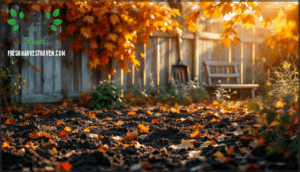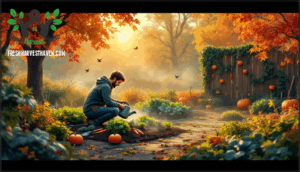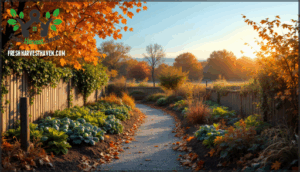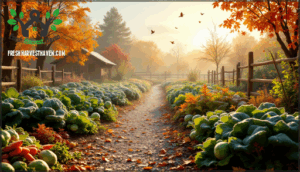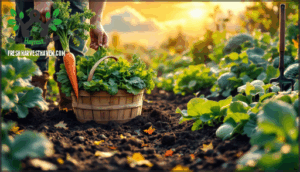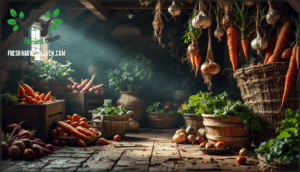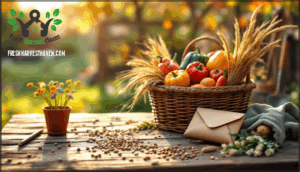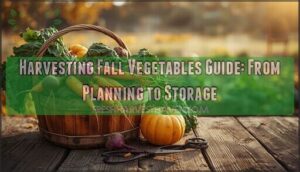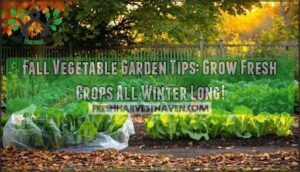This site is supported by our readers. We may earn a commission, at no cost to you, if you purchase through links.
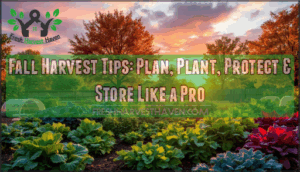
The trick is getting plants established while soil still holds warmth from August, then protecting them as temperatures slide. With the right timing and a few cold-weather strategies, you can pull fresh vegetables straight from the garden well into November, sometimes December.
Here’s how to plan, plant, protect, and store your way to a fall harvest that rivals anything you grew in spring.
Table Of Contents
- Key Takeaways
- Plan Your Fall Garden for Success
- Prepare Soil and Beds for Fall Planting
- Optimize Planting and Germination Techniques
- Protect and Maintain Fall Crops
- Harvest and Store Fall Vegetables Properly
- Frequently Asked Questions (FAQs)
- What is the best food to plant in the fall?
- When to start seeds for fall harvest?
- How to maximize harvest?
- What should you not plant in the fall?
- How do I know when carrots are ready?
- Whats the best soil temperature for planting?
- Can I harvest during light frost conditions?
- How long do stored potatoes typically last?
- Should I water crops right before harvest?
- How deep should I plant fall bulbs?
- Conclusion
Key Takeaways
- Fall crops like carrots, greens, and root vegetables develop sweeter, more concentrated flavors after light frost because cold temperatures trigger sugar production in plants, making October harvests often superior to spring ones.
- Successful fall gardening hinges on backward planning from your first frost date—add two weeks to seed packet maturity times to account for slower growth from shorter days and cooler temperatures.
- Raised beds offer faster soil warming and better drainage for establishing fall crops before temperatures drop, while mulching and row covers provide essential frost protection that can extend your harvest by several weeks.
- Proper storage transforms your fall harvest into winter provisions—root crops stored in damp sand at 32-34°F with high humidity can last three to six months, while saving seeds from your best plants banks free starts for next season.
Plan Your Fall Garden for Success
Planning a fall garden isn’t about guessing—it’s about timing, choosing the right crops, and working with your local climate. You need to know what grows well in cooler weather, when to get it in the ground, and how to pick varieties that’ll actually mature before frost hits.
Let’s walk through the key decisions that set you up for a successful fall harvest.
Choosing Cool-Season and Quick-Maturing Crops
Your cool-season choices set the stage for a thriving Fall garden. Focus on lettuce, spinach, carrots, turnips, and radish—these cool-season crops tolerate light frosts and deliver better flavor when temperatures drop.
If you’re planting early in mid-July through August, consider quick options like arugula (21-40 days) or green beans (50-60 days) alongside broccoli and Brussels sprouts for extended harvests. Maturation timing matters: shorter days to maturity mean more success before frost hits.
Understanding the best cool season crops is vital for a successful fall garden.
Calculating Planting Dates Before Frost
Once you know what to grow, you’ll need to work backward from your first expected frost date—and build in extra time—to figure out when those seeds or transplants actually need to go in the ground.
Find your area’s average first frost, then count back the days to maturity listed on your seed packet, adding about two weeks to account for slower growth as daylight fades and temperatures drop.
Selecting Short-Season Vegetable Varieties
Not all varieties will make it to harvest if they need too long to mature, so look for short-season types bred to finish faster—usually 60 days or less—so they can beat the cold.
Seed packets will list "days to maturity," but favor anything marked for late-season or fall planting, as these cool-season crops are built to tolerate dropping temps and shorter days without stalling out mid-growth.
Using Regional Planting Guides
Your USDA zone isn’t a guess—it’s your planting deadline. Regional planting guides factor in frost dates, elevation, and recent climate trends to give you precise windows for fall crops.
Since planting times can shift up to six weeks between zones, using zone-specific calendars helps you match cool-season crops and regional varieties to your microclimate, cutting crop loss by up to 40%.
Understanding your area’s fall planting guides is essential for a successful harvest.
Prepare Soil and Beds for Fall Planting
You can’t just toss plants in tired soil and hope for the best. Fall crops need a solid foundation to withstand cooler temperatures and shorter days, so prepping your beds now sets you up for a strong harvest later.
Here’s what you need to focus on before planting.
Amending With Compost and Organic Matter
Your fall garden’s success starts in the soil—think of compost and organic matter as the foundation that feeds your plants all season long. Work a generous layer of finished compost into your beds before planting—it boosts soil microbes, improves structure, and delivers nutrients your crops need.
You can also brew compost tea or apply organic fertilizers to give plants an extra edge while supporting carbon sequestration and overall soil health.
Mulching to Retain Warmth and Moisture
Mulch acts like a blanket for your fall garden—it locks in soil warmth, keeps moisture from evaporating, and gives your crops the steady conditions they need to thrive.
Layer straw, shredded leaves, or wood chips around cool-season crops for soil insulation and weed suppression.
You’ll protect root crops from freezing while extending your harvest window well into late fall.
Benefits of Cover Crops for Soil Health
Cover crops are your fall garden’s insurance policy—they rebuild what your summer vegetables took out. When you plant a cover crop like rye or clover after harvest, you’re feeding the underground ecosystem that keeps your soil alive.
These plants boost microbial activity, lock in nutrients through nutrient cycling, and prevent soil erosion while building organic matter. They’re natural crop rotation partners that support carbon sequestration and long-term soil conservation, setting you up for a stronger spring garden.
Raised Beds Vs. In-Ground Beds for Fall
Choosing between raised beds and in-ground plots isn’t just about convenience—it’s about stacking the deck in your favor when fall temperatures start to swing.
Raised beds warm up faster and drain better—critical for establishing cool-season crops before soil temperatures drop. In-ground beds retain moisture longer and need less winterization, but proper mulch and bed construction make either option work for your fall garden.
Optimize Planting and Germination Techniques
Getting fall crops off to a strong start takes some strategy, especially when cooler nights start rolling in. The right planting and germination techniques can mean the difference between a thriving garden and one that struggles to take root.
Here’s how to give your fall vegetables the best shot at success.
Starting Seeds Indoors for Better Germination
When fall’s cooler nights start rolling in, germinating seeds outdoors becomes about as reliable as a coin flip—but starting them indoors gives you a head start and much better odds. A seed tray on a sunny windowsill or under indoor lighting keeps soil temperature consistent, boosting germination rates markedly.
Once seeds sprout and develop strong roots, you can transplant them into prepared beds where they’ll thrive despite cooler conditions.
Establishing Plants Before Soil Cools
Your transplants won’t stand a chance if you get them in the ground too late—timing is everything when soil temperatures start their steady decline toward winter. Aim to transplant cool-season crops while soil still holds residual warmth from summer, giving roots time to anchor and develop before cold nights stall growth.
That window of establishment makes all the difference between plants that thrive and those that barely limp along through fall.
Succession Planting for Continuous Harvests
Instead of betting everything on one big planting date, stagger your sowings every 7 to 14 days so you’re not drowning in lettuce one week and eating plain rice the next. This harvest staggering approach keeps your fall garden productive through the late season.
- Plant fast growers like arugula and radishes every week for continuous harvests
- Track your seed scheduling to avoid gaps in cool-season crops
- Adjust plant spacing to accommodate multiple growth phasing cycles
Crop rotation naturally happens when you’re extending the growing season this way.
Transplanting Vs. Direct Sowing in Fall
Once you’ve got your succession game running, you’ll need to decide whether to start plants indoors and move them out or just scatter seeds straight into the bed. Transplanting cool-season crops like broccoli gives you a head start on root development and better soil acclimation, while direct sowing seeds works great for quick growers that don’t appreciate being disturbed.
Watch your sowing depths and seedling care—fall transplants need time to settle before the cold hits.
Protect and Maintain Fall Crops
Once your fall crops are in the ground, your job isn’t over—you’ll need to shield them from dropping temperatures and keep an eye out for problems that could derail your harvest. The right protection strategies can mean the difference between a thriving garden and one that fizzles out before first frost.
Here’s how to keep your crops safe and productive through the season.
Using Row Covers and Cold Frames
Row covers and cold frames act like cozy blankets for your fall garden, trapping warmth and shielding plants from biting winds while still letting in the sunlight they need to thrive. Here’s what makes them game-changers for season extension:
- Lightweight row cover materials add 2-10°F of frost protection without crushing delicate greens
- Cold frame designs create mini-greenhouses that turn cool-season crops into winter survivors
- Garden insulation from mulch plus covers keeps roots cozy even when temperatures plummet
- Ventilation on sunny days prevents overheating—prop open cold frames when it warms up
- Reusable season after season, making them smart investments for serious gardeners
Frost Protection Strategies for Vulnerable Plants
Even with row covers and cold frames in your arsenal, some plants still need extra attention when frost threatens—think of it like layering up for a cold snap yourself. Drape frost blankets over vulnerable cool-season crops when your frost date approaches, or pile on winter mulch around the base to insulate roots.
For serious freeze protection, combine row covers with cold frames for double-duty warmth, and always have burlap or old sheets ready for surprise cold snaps.
Monitoring Weather and Soil Temperatures
Keeping tabs on temperature shifts—both in the air and in the ground—is your secret weapon for timing fall plantings and knowing when to throw on extra protection. Check frost alerts daily as your frost date nears, and use a soil thermometer to track when soil cooling slows germination.
Watch for temperature fluctuations that signal it’s time to adjust mulch for soil moisture or prep beds—climate trends matter more than single readings.
Natural Pest and Disease Management
Biological control offers real protection without harsh chemicals—studies show it cuts pest abundance by 63% and crop damage by over half. Rotate crops annually to disrupt pest cycles and lower soil-borne disease by up to 75%.
Biological control slashes pest damage by over half without chemicals—rotate crops yearly to cut soil disease by 75%
Clean up debris in fall to reduce overwintering pests, then apply organic sprays like neem oil every week or two for disease resistance and solid pest management that protects soil health and crop protection.
Harvest and Store Fall Vegetables Properly
You’ve protected your fall crops through the cool nights—now it’s time to bring them to the table. Knowing when and how to harvest makes all the difference between bland vegetables and sweet, flavorful produce.
Here’s how to harvest and store your fall bounty so nothing goes to waste.
Timing Harvests for Peak Flavor and Quality
The difference between a good carrot and a great one often comes down to a single day—harvest too early and you miss the sweetness, wait too long and frost can turn your prize vegetables to mush.
Your fall garden harvest depends on crop monitoring and understanding flavor profiles. Check vegetables regularly as frost approaches, using visual cues and taste tests for quality control.
Most fall harvest crops improve after light frost, but timing matters for peak flavor and successful season extension.
Techniques for Harvesting Greens and Root Crops
Harvesting greens and root crops isn’t rocket science, but knowing whether to cut, pull, or pluck can mean the difference between a tender salad and a handful of damaged leaves.
For greens harvesting in your fall garden, snip outer leaves a few at a time—this keeps cool-season crops producing through soil temperature drops.
Root crops need gentle pulling once loosened, checking for proper size without damaging neighboring plants during crop rotation areas.
Storing Crops for Winter Use
Your fall harvest doesn’t end at the garden gate—proper cold storage tips can stretch root crops and cool-season crops well into winter.
Store carrots and beets in damp sand at 32–34°F with humidity above 85%, keeping them from touching to prevent rot. Leafy greens last up to three weeks near freezing, while garlic and onions prefer drier conditions around 60–70% humidity for winter harvesting success.
Saving Seeds From Fall Harvest
Collecting seeds from your best-performing fall crops is like banking free groceries for next season—and it’s easier than you think. Here’s your simple seed-saving roadmap:
- Seed Selection — Choose disease-free plants with great flavor and strong growth
- Harvest Timing — Wait until seeds fully mature and dry on the plant
- Seed Cleaning — Remove debris and let seeds cure in a dry, ventilated spot
- Storage Methods — Keep seeds cool, dark, and moisture-free in labeled envelopes
- Germination Rates — Test viability before spring planting for best seedlings
Frequently Asked Questions (FAQs)
What is the best food to plant in the fall?
Cool-season crops like broccoli, Brussels sprouts, and cauliflower are absolutely unbeatable for fall gardens.
Root vegetables such as carrots and beets thrive in cooler weather, while autumn lettuce and other brassica crops tolerate light frosts beautifully.
When to start seeds for fall harvest?
Start seeds for your fall garden in mid-July to mid-August, counting back from your frost date and adding extra time.
Cool-season crops need establishment before soil cools, so seed germination timing matters for a successful harvest.
How to maximize harvest?
Funny how everyone talks about when to plant, but maximizing your vegetable harvest really comes down to succession planting, choosing varieties with side shoots, and using Season Extension Techniques like cold frames to keep Harvest Timing flexible as Soil Temperature Control drops.
What should you not plant in the fall?
Avoid warm-season crops like tomatoes, peppers, and squash—they’re heat-loving plants that won’t survive fall temperatures. Frost-sensitive trees, tender bulbs, and summer flowers also fail in cooler conditions.
Stick to cool-season crops for successful harvest time.
How do I know when carrots are ready?
You’ll know your carrots are ready when the tops measure about three-quarters to one inch across at the soil line. Gently brush away some soil to check root size—carrots develop better flavor after experiencing cooler soil temperatures, especially in fall.
Whats the best soil temperature for planting?
You might think any warmth works, but soil temperature matters more than air temperature for fall gardening success.
For cool-season crops, aim for 50–75°F for seed germination. Most fall vegetables germinate best around 60–70°F, though root development continues as soil cools.
Can I harvest during light frost conditions?
Yes, you can harvest during light frost conditions. Cool-season crops like kale, spinach, and carrots actually tolerate light frosts well and often develop better flavor. Just time your harvest after frost lifts to avoid touching frozen, brittle leaves.
How long do stored potatoes typically last?
Properly stored potatoes can last three to six months in a Root Cellar or cool, dark space.
Keep them between 40-50°F with good ventilation for ideal Potato Shelf Life and Food Safety during Fall Harvest season.
Should I water crops right before harvest?
Wait before watering—dry soil concentrates sugars, boosting flavor. For greens and leafy vegetables at harvest time, withhold water a day or two before harvesting vegetables.
This pre-harvest care reduces water stress while enhancing crop quality during your fall harvest.
How deep should I plant fall bulbs?
Bulb planting depth matters for fall gardening success—plant bulbs two to three times deeper than their diameter. That’s your golden rule for proper bulb storage tips and garden bed prep.
A two-inch bulb goes four to six inches deep, with the pointed end facing up.
Conclusion
Like a squirrel preparing for winter, you’ve now got everything you need to turn October’s chill into an advantage. These tips for successful fall harvest aren’t about fighting the cold—they’re about working with it.
Plant when soil still holds warmth, protect what’s growing as frost arrives, and harvest when sugar concentrations peak.
Your fall garden won’t just survive the season—it’ll produce vegetables that taste better than anything summer delivered. Time to get your hands dirty.
- https://app.farmraise.com/pricing?promoCode=8MELC9
- https://homegarden.cahnr.uconn.edu/2025/05/03/hardiness/
- https://awaytogarden.com/what-to-plant-now-for-a-fall-vegetable-garden/
- https://www.gardentowerproject.com/blogs/learning-center/vegetable-planting-schedule
- https://www.pubs.ext.vt.edu/content/dam/pubs_ext_vt_edu/426/426-331/SPES-673.pdf

